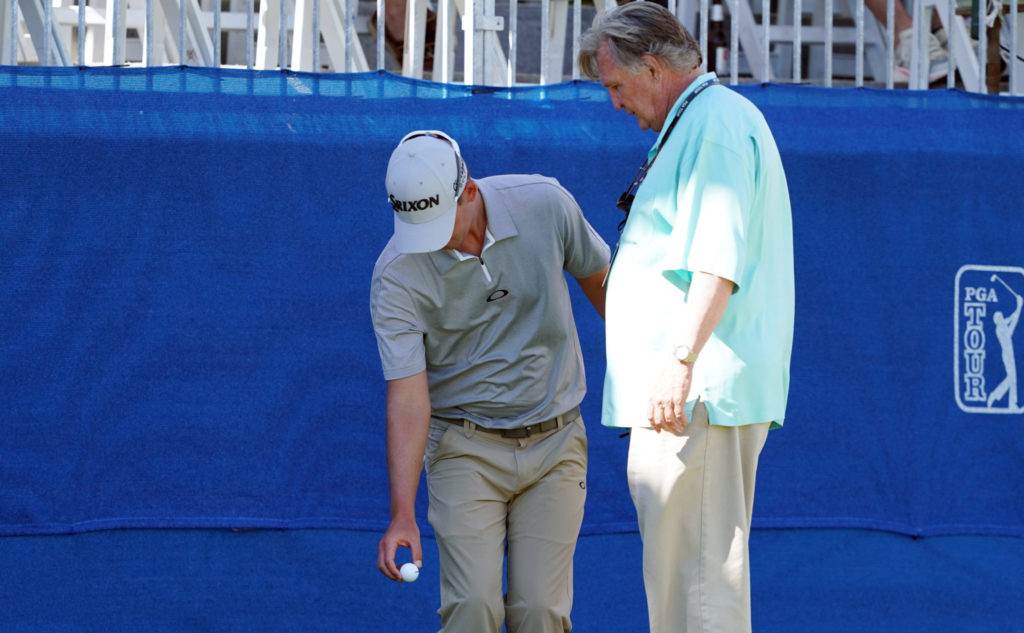With new rules in play, caddies take extra cautious approach

If there’s any question at all about the new rules changes enacted by the United States Golf Association and the Royal and Ancient beginning this year, don’t hesitate to ask an expert. That’s the unanimous opinion of three veteran PGA Tour caddies who recently discussed how those changes may affect the way they handle unusual occurrences — and even things like routine drops — during play in 2019.
The major rules changes are listed in eight categories: ball at rest, ball in motion, taking relief, areas of the course, equipment, playing a ball, pace of play and behavior. Understanding what caddies can and cannot do, particularly when it comes to unusual cases, has required a different approach for this season.
Joe Duplantis said calling on rules officials at a PGA Tour event is more important than ever, because a simple blunder can turn into a major gaffe if you interpret the new rules incorrectly.
“Nobody is confident enough really to do it on their own and cause themselves a penalty,” he said. “The officials know that and they’re readily available.”
Matt Hauser agreed, saying it will take some time to figure out exactly how to implement the changes, particularly on drops and penalty areas. Until you’ve actually put yourself in a particular position, it’s difficult to know the right way to proceed.
Hauser used the term “quirky” to describe several of the new rules.
RELATED: Here’s how the rules changes for 2019 will impact caddies
“It’s just trying to get a grasp of it but there are officials everywhere on the golf course so if you have a question, it’s pretty easy just to call somebody to go over it,” Hauser said. “They know the rules. That’s why they’re out there, to help you double- or triple-check things. The last thing you want to do is get a penalty for something stupid so they’re awesome. For everything from basic drops to line-of-sight.
“The key is to call over a rules official just to make sure you’re not doing the wrong thing. I know you had to drop from shoulder height in the past and now you drop from knee height and it has to be within a certain circle so guys will probably go over that a few times before they start doing it themselves.”
Even for veteran loopers, trying to determine which situation calls for a one or two club-length drop isn’t always clear. Duplantis has already run into that situation this year and thinks he has it figured out for now.
“There are only penalty areas. There are no hazards,” Duplantis said. “But we have a yellow line and a red line in the penalty areas, and I’m not sure of the difference and what that means yet. Usually, the yellow line means we have a drop zone. But we’ve been in yellow areas that don’t have a drop zone so we drop it like if it was a red line. So there’s a bit of confusion between those for me.
“I went to the official and he said a penalty is two club-lengths and if it’s a free drop, you get one club-length. But we had just the most regular occurrence — hitting it into the water on a par 3 — and everyone had a different idea of what you’re supposed to do.”
The idea of dropping the ball from knee level now instead of even with the shoulder takes some getting used to. But Hauser, Duplantis and Don Donatello all said the new rule should allow players to spend less time going through the process of dropping the ball multiple times and then having to place it.
“The one club-length drop was needed and easier than dropping the ball two times,” Donatello said.
Another rule designed to speed up play — reducing the time allowed to find a lost ball from five to three minutes — was met with approval. It eliminates the two-stroke penalty in case a player or his caddie accidentally steps on a ball while trying to locate it.
“Obviously, three minutes to find a lost ball is less time, but if you accidentally kick the ball while you’re looking for it, it’s no big deal,” Hauser said. “Before, you were almost better having other people look.”
Another two-stroke penalty taken off the books involved the rare instance when a ball unintentionally caroms off a player, caddie or the bag.
MORE: The unwritten rules of caddying | 23 of the best caddie one-liners
“In 20 years of caddying, I’ve heard of a caddie getting hit maybe twice?” Duplantis said. “So it’s extremely rare, but it does give you a sense of ease knowing that.”
Hauser agreed.
“Any ball that hits you, hits the bag or hits your player is a great improvement,” he said. “If you hit it in the bunker, and you hit it out and it hits the lip and comes back and hits you, you’re already hit a poor shot. Two more shots just because the ball touched you or the bag has never made sense.”
All three veterans agreed that intent will be a critical factor, particularly when it comes to drops, repairing spike marks on the greens, getting relief from sprinkler heads around the greens and plugged balls. Players will still be held to a high standard of professional integrity.
But Donatello wondered if perhaps the USGA and R&A should have gone the extra step and created different rule books for professionals and amateur players.
“I know they are trying to make the game faster but the rules should not be the same for a professional and amateur,” Donatello said. “For example, a professional golfer can swing the club harder than an amateur. If you are hitting your driver, 3-wood or other clubs in a tournament round and one breaks or you crack the face, you can’t get another club to replace it.
“The USGA’s comment was just start the tournament with 13 clubs, then if a club breaks you can put another club in as long as there is only 14 clubs. But the rules should be different between amateurs and Tour players and professionals.”





